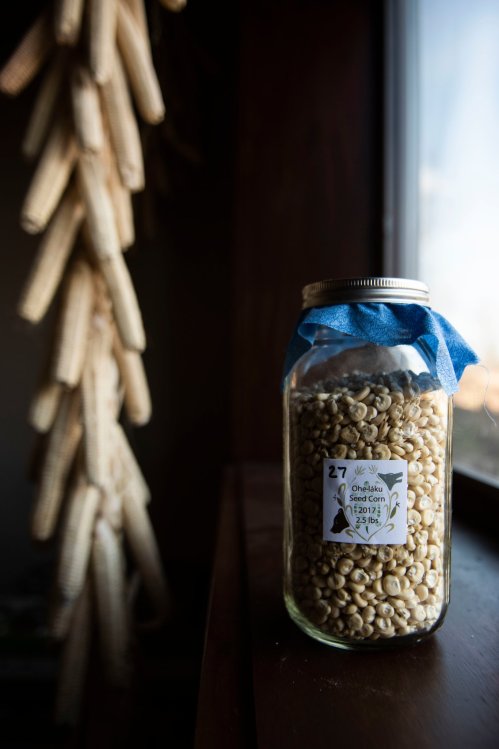
Photo: Lauren Justice for the New York Times
“Faced with grocery shortages,” reports the New York Times, “many Native Americans have started collecting seeds to plant in their gardens at home.” Among members of the Oneida Nation, white corn, above, is prized for its versatility and nutrient density.
As many of us non-gardeners start to wonder if we could grow tomatoes and lettuce in the kitchen window, we look with envy at people who can feed themselves without grocery stores.
Recently I read an article in the New York Times by Priya Krishna about indigenous Americans who, although suffering in the pandemic like the rest of us, at least have ancient wisdom they can dust off to help them survive.
“For the roughly 20,000 members of the Oglala Sioux Tribe living on the Pine Ridge Indian Reservation — a vast, two million-acre expanse in southern South Dakota — social distancing is certainly feasible. Putting food on the table? Less so.
“Getting to food has long been a challenge for Pine Ridge residents. For a lot of people, the nearest grocery store is a two-hour drive away. Many rely on food stamps or the Food Distribution Program on Indian Reservations, a federal initiative that provides boxes of food (historically lacking in healthy options) to low-income families. Diabetes rates run very high.
“The coronavirus crisis [has] only made access to food harder, as shelves of the few groceries empty out, shipments of food boxes are delayed because of supply chain disruptions, and hunting and gathering are restricted by government regulations and environmental conditions.
“But the Oglala Sioux, like many other Native Americans across the country, are relying on the practices — seed saving, canning, dehydrating — that their forebears developed to survive harsh conditions with limited supplies. …
“Big-box stores and processed foods have eroded some of the old customs. But now, faced with a disrupted food system, many Native Americans are looking to those traditions for answers.
“Milo Yellow Hair, who lives in Wounded Knee, S.D., on the Pine Ridge Reservation, is hard at work preparing 8,000 seedlings of local varieties of squash and corn — hearty crops with a short growing time — to plant in people’s yards. …
‘Here on the reservation it is a day-by-day existence,’ said Mr. Yellow Hair, 70, who works for the nonprofit Slim Buttes Agricultural Development Program. ‘If this thing goes crazy and the external food services stop, the food we grow locally is going to be paramount to meet this need.’ …
“The coronavirus emergency is dire on the Navajo Nation in Arizona, Utah and New Mexico, which as of [April 13] had 698 cases and 24 deaths. …
“The Turtle Mountain Band of Chippewa has a strong tradition of canning local crops like beets, cucumbers and carrots, and some families are known for their expertise. Many are now donating their stockpiles to those on the reservation in need.
“ ‘You don’t think twice about it,’ said [Jamie Azure, the tribal chairman of the Turtle Mountain Band of Chippewa, in Belcourt, N.D. ]. ‘And then when the Covid-19 threat comes through, you realize how important all of this is.’
“In Alaska, the Athabaskan peoples have long dealt with brutal, protracted winters by preserving produce and freezing meats. Cynthia Erickson, who is Athabaskan and an owner of the only grocery store in her village, Tanana, has a freezer full of moose, caribou and whitefish. But she has been struggling to get her usual wholesale suppliers to fill orders. The tribe may ask Gov. Mike Dunleavy to open moose hunting season (which normally begins in August or September) early if the food supply runs low, she said. …
“After much of his work dried up, Brian Yazzie, a private chef in St. Paul who is Navajo, decided to volunteer at the Gatherings Café in Minneapolis, which is feeding Native American seniors. He is cooking almost exclusively with traditional Native ingredients, making stew out of tepary beans from Ramona Farms in Sacaton, Ariz., and cooking elderberries into a sauce for barbecue chicken.
‘Indigenous peoples survived colonization, and so has our food and ingredients,’ said Mr. Yazzie, 33. ‘Practicing our foodways is a sign of resiliency.’ …
” ‘As this pandemic continues to grow,’ [says Chelsey Luger, who co-founded an indigenous wellness program with her husband], ‘I can tell you that I feel safer on the reservation than anywhere else.’ ”
More at the New York Times. here.

They sure know a thing or two about hard times and how to get through.
I liked the Chippewa chairman’s comment: “You’re forced to stay in a specific area, you’re told to trust the government, you’re told food will be scarce — welcome to 1700s Native nation.”
So sad, so sad.
Thanks for the good news about healthy traditions and self reliance on reservations. We could all follow their good example. Our chives wintered and are doing well. Still waiting until Mother’s Day to plant our crops. Say, did you just pass 2000 followers this week? Congratulations, well deserved. : ) Rebecca
Yes, I am so grateful for followers. I have been doing this every day for nine years, and I guess some early ones are not following anymore, but people who comment continue to make my day!
Nine years! That’s amazing. I appreciate the thoughtfulness in the subjects you choose – so uplifting!
From Deb at A Bear’s Thimble, https://abearsthimble2.wordpress.com/: “I’ve wondered how some are making out with stores being short on supplies. It has made me truly thankful to be on a farm! We might have to do without some things, but we wouldn’t go hungry.”
That’s exactly what I’ve been thinking, Deb.You are also very resourceful with making tools and other things you need, as I know from reading your blog.